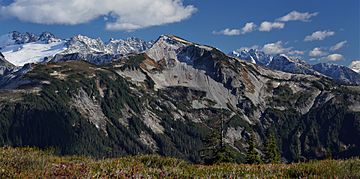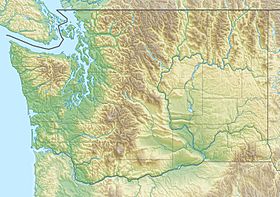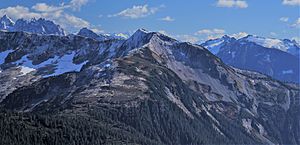Easy Peak facts for kids
Quick facts for kids Easy Peak |
|
|---|---|

Northwest aspect seen from Copper Ridge
(Picket Range behind) |
|
| Highest point | |
| Elevation | 6,613 ft (2,016 m) |
| Prominence | 373 ft (114 m) |
| Isolation | 1.98 mi (3.19 km) |
| Parent peak | Mineral Mountain (6,800+ ft) |
| Geography | |
| Location | North Cascades National Park Whatcom County, Washington, U.S. |
| Parent range | Cascade Range North Cascades Skagit Range |
| Topo map | USGS Mount Blum |
| Climbing | |
| Easiest route | class 2 hiking |
Easy Peak is a mountain in the Skagit Range of the North Cascades. It stands 6,613-foot (2,016-metre) tall in Whatcom County, Washington state.
This peak is located inside North Cascades National Park. Many hikers climb Easy Peak when they are on their way to Mount Challenger and the faraway northern Pickets. The closest taller mountain is Mineral Mountain, about 2 mi (3.2 km) to the west. Whatcom Peak is about 2.1 mi (3.4 km) to the east. Small patches of ice, called glacierets, can be found on the north side of Easy Ridge, between Easy Peak and Whatcom Peak. Water from this mountain flows north into the Chilliwack River or south into the start of the Baker River.
Weather at Easy Peak
Easy Peak is in a marine west coast climate zone. This means it gets a lot of rain and snow. Most of the weather comes from the Pacific Ocean. These weather systems travel northeast towards the Cascade Mountains.
When the weather systems reach the North Cascades, the tall mountains force the air upwards. This makes the air cool down and drop its moisture as rain or snowfall onto the Cascades. Because of this, the western side of the North Cascades gets a lot of rain and snow, especially in winter. The snow here is often wet and heavy, which can make it easy for avalanches (large slides of snow) to happen.
In winter, the weather is usually cloudy. But in summer, high pressure systems over the Pacific Ocean often bring clear skies. The best time to visit Easy Peak for good weather and views is from July through September.
How Easy Peak Was Formed
The North Cascades area has very rugged land with sharp peaks, ridges, and deep valleys carved by glaciers. The way this land looks today was created by huge geological events that happened millions of years ago. These events caused big changes in height across the Cascade Range, which also led to different climates and types of plants in the area.
The Cascade Range started forming millions of years ago, during the late Eocene Epoch. This happened because the North American Plate was slowly moving over the Pacific Plate. This movement caused many volcanic eruptions. Also, small pieces of the Earth's crust, called terranes, came together to form the North Cascades about 50 million years ago.
During the Pleistocene period, which was over two million years ago, glaciers grew and shrank many times. As these huge ice sheets moved, they scraped and shaped the land, leaving behind piles of rock. The river valleys in this area have a "U" shape, which is a clear sign that glaciers carved them. The combination of the land pushing up (called uplift) and breaking along cracks (called faulting), along with the action of glaciers, created the tall peaks and deep valleys we see in the North Cascades today.




